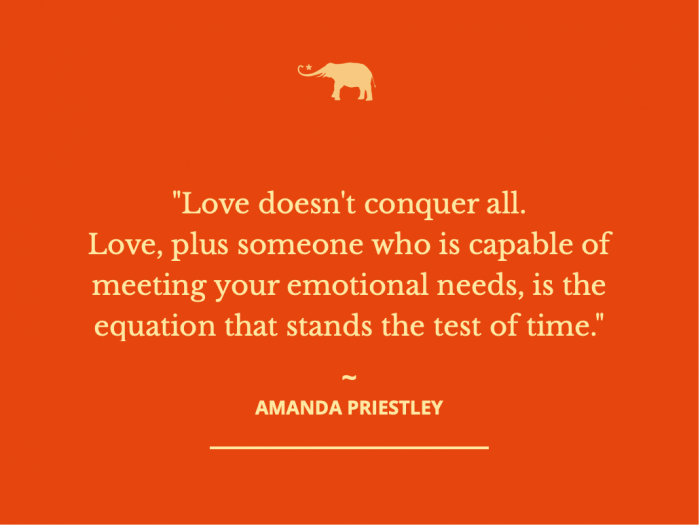We often spend years in relationships that have little potential of providing mutual contentment, wondering how to fix them, or worse, simply accepting that relationships are difficult endeavors. I used to think that too, until I discovered the one explanation that ties it all together in perfect clarity—attachment theory.
When my significant other feels any sort of conflict or perceived threat to our relationship, his anxiety spikes, and his focus is to get close again. He might send me a few text messages, or catch me in the kitchen for a hug. And I, for my part, will probably pull further away, feeling a bit smothered.
I used to think this was because he was a more passionate, live-out-loud personality, while I was an introvert. After all, he wanted to express all of his emotions the moment they happened, so it made sense that he wanted instant resolution. And I needed a lot of time and space to myself, which conflicted with his demonstrative style.
I read Attached by Amir Levine, M.D. and Rachel S. F. Heller, M.A., and the real story was suddenly uncovered: my partner was anxiously attached, and I was on the border of avoidant and secure.
Someone who is anxiously attached needs constant reassurance, whilst I needed regular breaks from intimacy in order to ground myself. Unless we could both learn to be more secure, we would constantly aggravate each other’s attachment issues.
Attachment theory outlines three basic adult attachment styles that mirror the attachment of young children: avoidant, anxious, and secure. Through a mix of our genes, childhood, parents, and experiences, Levine says that we develop an attachment style, which serves as the blueprint for our adult relationships.
People who are avoidant don’t feel comfortable with sustained intimacy. When they experience closeness, they may enjoy it, but then need a break from it. They pull away when they smell too much emotional dependency in the air. They value their independence and fear having to compromise it.
I relate. I like being close, but it needs to be interspersed with time to myself. I have my own bedroom (typical for avoidants), like to travel by myself, and I’ve always liked a bit of secrecy to protect new hobbies or pursuits.
People who are anxious are the opposite. They want constant intimacy and validation of the other person’s feelings. They can be jealous or insecure unless provided with reassurance. They fear abandonment and therefore have trouble leaving relationships.
The securely attached people among us feel confident in their ability to give and get love. They communicate their emotional needs clearly, and can handle the waves of a relationship without freaking out. They put their partner’s needs at the top of the priority list.
The fascinating thing about the attachment theory is that when people are with someone who has the same emotional and intimacy needs as themselves, they are a lot happier in life. And anyone who is with a secure partner seems to reap the benefits of their security, even if they are avoidant or anxious—it just feels better, like a true partnership.
On the other hand, anxious people in a relationship with an avoidant person may never feel a sense of fulfillment and ease with their partners. The anxious person continues to get pushed away, while the avoidant person feels unpleasantly possessed. There may be times of closeness that feel like the height of love and romance, followed by painful distance. These relationships rarely lead to long-term happiness.
Avoidant people with other avoidant people tend to have relationships that fizzle out, with neither party pushing to stay connected. Anxious people with other anxious people can make it work, but they tend to be perceived as overly enmeshed by the rest of us. They go everywhere together, have a hard time pursuing individual activities, and usually are heavy on public displays of affection.
The burning question I had while reading Levine’s book was this: “Can you change your attachment style?”
The answer is that, like with most parts of our personality or history, we can tweak it with effort and practice. Those who are avoidant or anxious can learn the skills that mimic a securely attached person. We can improve our communication, make it more direct, and give our partners the benefit of the doubt. We can practice compromise when it comes to our level of intimacy, and if we are with a secure partner, we can recognize that their style is a healthier one, and let them take the lead.
But the first step on the attachment journey is determining your style by taking an attachment quiz. I also highly recommend Heller and Levine’s book, which will flip everything you think about relationships on its head. From there, you can figure out the best match for you—which, spoiler alert, is almost always a securely attached person. And if you are with someone who has the wrong style, one that can never bring you peace and consistent love, it may be time to leave. You can take heart in knowing it would’ve never worked—years of careful research by Levine and others prove it.
My partner and I may have to face the hard truth that unless either of us can move closer to being secure, we are destined to always aggravate each other’s attachment difficulties.
Love doesn’t conquer all. Love, plus someone who is capable of meeting your emotional needs, is the equation that stands the test of time.
Being armed with the information about our own attachment style and what we need, clarifies the search for the right relationship.









Read 2 comments and reply